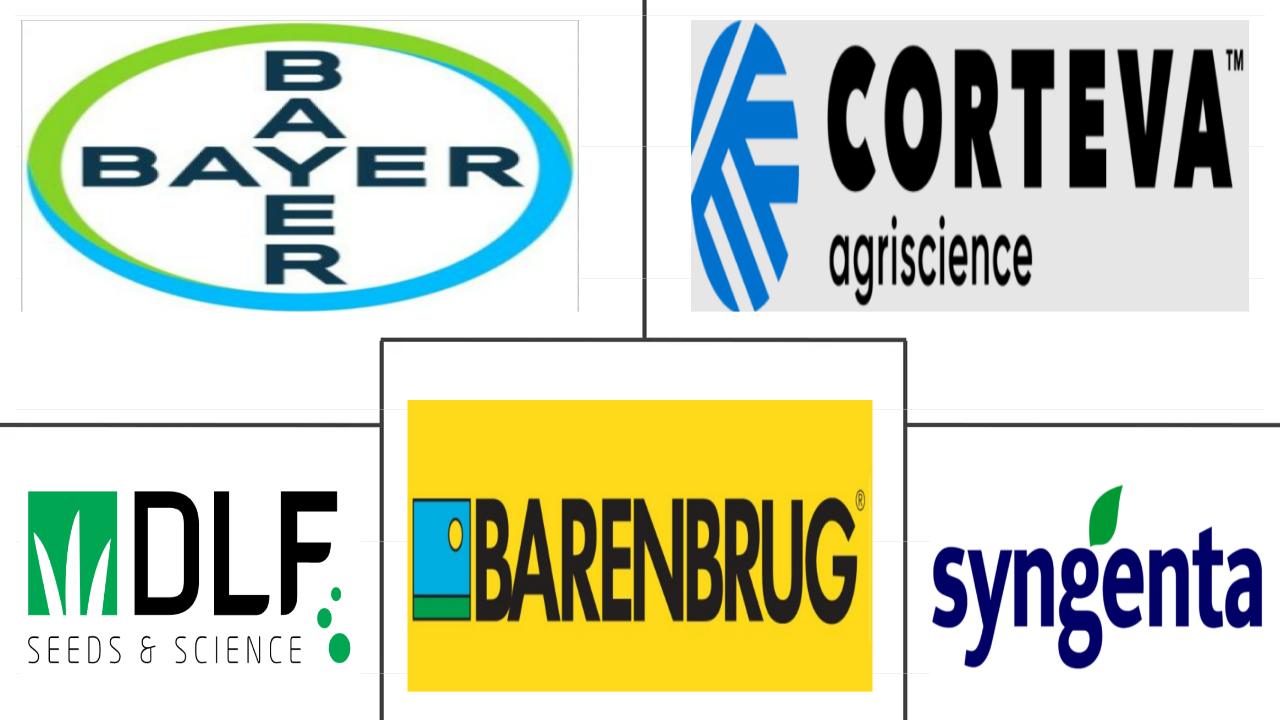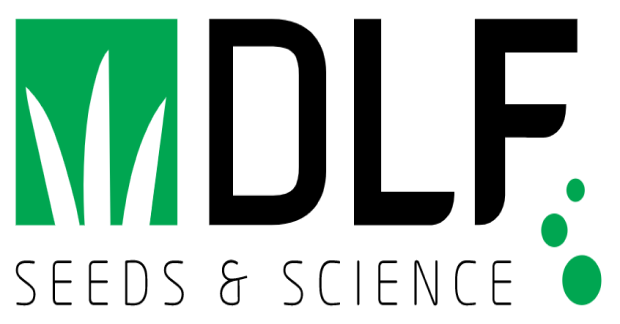Market Size of alfalfa seed Industry
|
|
Study Period | 2017 - 2030 |
|
|
Market Size (2024) | USD 1.08 Billion |
|
|
Market Size (2030) | USD 1.35 Billion |
|
|
Largest Share by Breeding Technology | Hybrids |
|
|
CAGR (2024 - 2030) | 3.70 % |
|
|
Largest Share by Region | Europe |
Major Players |
||

|
||
|
*Disclaimer: Major Players sorted in no particular order |
Alfalfa Seed Market Analysis
The Alfalfa Seed Market size is estimated at 1.08 billion USD in 2024, and is expected to reach 1.35 billion USD by 2030, growing at a CAGR of 3.70% during the forecast period (2024-2030).
1.08 Billion
Market Size in 2024 (USD)
1.35 Billion
Market Size in 2030 (USD)
2.97 %
CAGR (2017-2023)
3.70 %
CAGR (2024-2030)
Largest Market by Breeding Technology
77.61 %
value share, Hybrids, 2023
The large share of hybrids is associated with the development and adoption of transgenic hybrids, increased area under hybrids, high palatability, and disease resistance.
Largest Market by Country
19.88 %
value share, Canada, 2023
It is due to the increased area under cultivation due to government initiatives, high profitability, and increased demand for feed from the livestock industry.
Fastest-growing Market by Breeding Technology
3.87 %
Projected CAGR, Hybrids, 2024-2030
The fastest growth of hybrids is expected due to the increasing area under transgenic alfalfa. Major companies are developing new hybrids with improved traits.
Fastest-growing Market by Country
9.72 %
Projected CAGR, Iran, 2024-2030
Iran has a high demand for alfalfa crops due to the high demand for better-quality meat, increasing cattle population, and awareness about quality feed among farmers.
Leading Market Player
12.16 %
market share, DLF, 2022

DLF Seeds is the most active company in the alfalfa seed market, which has increased its revenue through product innovations, partnerships, and mergers and acquisitions.
The increased adoption of hybrid seeds due to their improved traits such as disease resistance are driving the market.
- The livestock population is increasing across various regions around the world. The increase in livestock population needs an expansion of the area under forages, and alfalfa offers easily digestible fiber content. These are some of the major factors leading to the growth of the hybrid and open-pollinated alfalfa seed market.
- The hybrid segment tops the alfalfa seed market due to the increased adoption of hybrid varieties and increasing awareness about their benefits. The hybrid alfalfa seed market value is projected to increase by about 35.9% and reach USD 1.1 billion by the end of the forecast period. This is due to the rise in the seed replacement rate and the availability of improved varieties in the market.
- Increasing acceptance of advanced hybrid technology by growers, such as drought tolerance and disease resistance, is projected to contribute to hybrid alfalfa seed market growth in the coming years. For instance, in the United States, hybrids occupied 99% of the area under commercial seeds in 2022, which is attributed to the availability of high-yielding hybrid varieties and the development of transgenic alfalfa varieties from popular companies such as Allied Seed LLC, Bayer AG, and DLF.
- Africa is forecasted to be the fastest growing market in the OPVs segment at a CAGR of 3.2% because a small group of farmers in the country is projected to use OPVs over hybrids as they require fewer inputs, such as fertilizer and pesticides and are less expensive and more affordable for small holding and low-income farmers.
- Therefore, an increase in the cultivation area under commercial seeds and the demand from cattle growers for quality forage with more protein and digestible fiber content is projected to boost the market for hybrid seeds during the forecast period.
The increasing demand for alfalfa from livestock industry combined with growing cultivation area driving the market.
- Europe is the largest alfalfa seed market in the world. It accounted for about 41.1% of the global alfalfa seed market in 2022, with 3.2 million hectares under alfalfa cultivation. Italy was the largest producer and occupied a large area of alfalfa production in Europe. As there is a significant demand for better-quality meat, increased livestock production is likely to create a demand for better forage crops such as alfalfa, driving the market for alfalfa forage seeds in the region.
- In 2022, North America was the largest market in the global alfalfa seed market, with a share of about 29.0% of the global market due to the highest production, globally, weather conditions, and increased demand by dairy farmers. Canada has the greatest demand in the region because of the increase in demand for crops as feed, the increase in cultivation area, and high profitability.
- In Asia-Pacific, alfalfa is an important forage crop as the weather is favourable and demand for high protein feed is more from the livestock and cattle rearers in the region. The market share of the region was 16.5% in 2022, which is expected to increase at a CAGR of 2.4% during the forecast period as the adoption of alfalfa is increasing among farmers.
- South America accounted for about 6.5% of the global alfalfa seed market in 2022. The area cultivated has increased from 3.9 million hectares in 2017 to 4.4 million hectares in 2022. This increase in cultivation area is anticipated to drive the market at a CAGR of 3.0% during the forecast period.
- The increasing area under cultivation and rising demand for forage are the major factors anticipated to help in the growth of the alfalfa seed market.
Alfalfa Seed Industry Segmentation
Hybrids, Open Pollinated Varieties & Hybrid Derivatives are covered as segments by Breeding Technology. Africa, Asia-Pacific, Europe, Middle East, North America, South America are covered as segments by Region.
- The livestock population is increasing across various regions around the world. The increase in livestock population needs an expansion of the area under forages, and alfalfa offers easily digestible fiber content. These are some of the major factors leading to the growth of the hybrid and open-pollinated alfalfa seed market.
- The hybrid segment tops the alfalfa seed market due to the increased adoption of hybrid varieties and increasing awareness about their benefits. The hybrid alfalfa seed market value is projected to increase by about 35.9% and reach USD 1.1 billion by the end of the forecast period. This is due to the rise in the seed replacement rate and the availability of improved varieties in the market.
- Increasing acceptance of advanced hybrid technology by growers, such as drought tolerance and disease resistance, is projected to contribute to hybrid alfalfa seed market growth in the coming years. For instance, in the United States, hybrids occupied 99% of the area under commercial seeds in 2022, which is attributed to the availability of high-yielding hybrid varieties and the development of transgenic alfalfa varieties from popular companies such as Allied Seed LLC, Bayer AG, and DLF.
- Africa is forecasted to be the fastest growing market in the OPVs segment at a CAGR of 3.2% because a small group of farmers in the country is projected to use OPVs over hybrids as they require fewer inputs, such as fertilizer and pesticides and are less expensive and more affordable for small holding and low-income farmers.
- Therefore, an increase in the cultivation area under commercial seeds and the demand from cattle growers for quality forage with more protein and digestible fiber content is projected to boost the market for hybrid seeds during the forecast period.
| Breeding Technology | |||||||
| |||||||
| Open Pollinated Varieties & Hybrid Derivatives |
| Region | |||||||||||||||||
| |||||||||||||||||
| |||||||||||||||||
| |||||||||||||||||
| |||||||||||||||||
| |||||||||||||||||
|
Alfalfa Seed Market Size Summary
The alfalfa seed market is poised for significant growth, driven by the increasing global livestock population and the rising demand for high-quality forage. Alfalfa, known for its easily digestible fiber content, is becoming a preferred choice for livestock feed, particularly in regions with expanding dairy and meat production. The market is characterized by a shift towards hybrid and open-pollinated varieties, with hybrids leading due to their enhanced traits such as drought tolerance and disease resistance. This trend is supported by the adoption of advanced agricultural technologies and the availability of improved seed varieties from major companies. The hybrid segment, in particular, is expected to see substantial growth as farmers increasingly replace traditional seeds with high-yielding hybrids.
Regionally, Europe and North America dominate the alfalfa seed market, with Europe being the largest due to its extensive cultivation area and demand for better-quality meat. North America follows closely, driven by favorable weather conditions and high demand from dairy farmers. The Asia-Pacific region is also witnessing growth, with countries like China, Australia, and India increasing their alfalfa cultivation areas. In South America, the market is expanding as well, with a growing focus on adapting to changing agro-climatic conditions. The market is fragmented, with key players like Bayer AG, Corteva Agriscience, and DLF leading the charge in developing and promoting new alfalfa varieties. These companies are actively involved in strategic acquisitions and collaborations to enhance their product offerings and maintain a competitive edge in the global market.
Alfalfa Seed Market Size - Table of Contents
-
1. MARKET SEGMENTATION (includes market size in Value in USD, Forecasts up to 2030 and analysis of growth prospects)
-
1.1 Breeding Technology
-
1.1.1 Hybrids
-
1.1.1.1 Non-Transgenic Hybrids
-
1.1.1.2 Transgenic Hybrids
-
1.1.1.2.1 Herbicide Tolerant Hybrids
-
1.1.1.2.2 Other Traits
-
-
-
1.1.2 Open Pollinated Varieties & Hybrid Derivatives
-
-
1.2 Region
-
1.2.1 Africa
-
1.2.1.1 By Breeding Technology
-
1.2.1.2 By Country
-
1.2.1.2.1 Egypt
-
1.2.1.2.2 Ethiopia
-
1.2.1.2.3 Ghana
-
1.2.1.2.4 Kenya
-
1.2.1.2.5 Nigeria
-
1.2.1.2.6 South Africa
-
1.2.1.2.7 Tanzania
-
1.2.1.2.8 Rest of Africa
-
-
-
1.2.2 Asia-Pacific
-
1.2.2.1 By Breeding Technology
-
1.2.2.2 By Country
-
1.2.2.2.1 Australia
-
1.2.2.2.2 Bangladesh
-
1.2.2.2.3 China
-
1.2.2.2.4 India
-
1.2.2.2.5 Japan
-
1.2.2.2.6 Myanmar
-
1.2.2.2.7 Pakistan
-
1.2.2.2.8 Philippines
-
1.2.2.2.9 Vietnam
-
1.2.2.2.10 Rest of Asia-Pacific
-
-
-
1.2.3 Europe
-
1.2.3.1 By Breeding Technology
-
1.2.3.2 By Country
-
1.2.3.2.1 France
-
1.2.3.2.2 Germany
-
1.2.3.2.3 Italy
-
1.2.3.2.4 Netherlands
-
1.2.3.2.5 Poland
-
1.2.3.2.6 Romania
-
1.2.3.2.7 Russia
-
1.2.3.2.8 Spain
-
1.2.3.2.9 Turkey
-
1.2.3.2.10 Ukraine
-
1.2.3.2.11 United Kingdom
-
1.2.3.2.12 Rest of Europe
-
-
-
1.2.4 Middle East
-
1.2.4.1 By Breeding Technology
-
1.2.4.2 By Country
-
1.2.4.2.1 Iran
-
1.2.4.2.2 Saudi Arabia
-
1.2.4.2.3 Rest of Middle East
-
-
-
1.2.5 North America
-
1.2.5.1 By Breeding Technology
-
1.2.5.2 By Country
-
1.2.5.2.1 Canada
-
1.2.5.2.2 Mexico
-
1.2.5.2.3 United States
-
1.2.5.2.4 Rest of North America
-
-
-
1.2.6 South America
-
1.2.6.1 By Breeding Technology
-
1.2.6.2 By Country
-
1.2.6.2.1 Argentina
-
1.2.6.2.2 Brazil
-
1.2.6.2.3 Rest of South America
-
-
-
-
Alfalfa Seed Market Size FAQs
How big is the Global Alfalfa Seed Market?
The Global Alfalfa Seed Market size is expected to reach USD 1.08 billion in 2024 and grow at a CAGR of 3.70% to reach USD 1.35 billion by 2030.
What is the current Global Alfalfa Seed Market size?
In 2024, the Global Alfalfa Seed Market size is expected to reach USD 1.08 billion.

